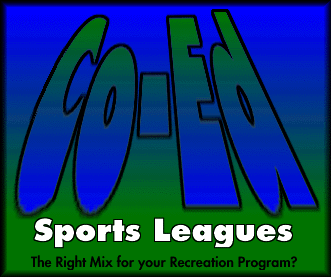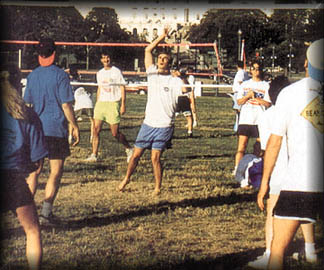

The Screaming Eagles are year round friends. In the spring and summer, the team plays ultimate Frisbee and volleyball and members "always go out afterwards". While in the winter, they take ski trips together. Like a number of people in their late 20's to early 30's, have taken up the sports they loved in high school, playing softball, soccer and the like in mixed leagues.
Neil McKinnon, who founded the Sport and Social Clubs of Canada, says when he moved to Vancouver three years ago he was eager to make friends and get involved in sports, but could not find a mixed league to join. So, he started one. "I wanted to bring people together, and thought this could be an opportunity to get people to do so in a non-competitive way" he says. The Vancouver league started out with 150 men and women playing on 32 teams in a variety of sports. Now it is a nation-wide operation and boasts more than 10,000 members. There are 500 teams in Vancouver alone.
In the Toronto area, the three branches of the Sport and Social Clubs are divided into west, central and east districts, and have been running for only a year. Currently they have more than 5,000 members.
The leagues run all of the popular sports - volleyball, flag football, soccer, basketball - as well as twists on old favourites, such as beach volleyball, ultimate Frisbee and in-line hockey.

Some players have joined as singles, while others sign up as couples. Many use the league to complement their workouts in the gym. For some, however, it is their only exercise. Teams play for an hour and a half, usually at local high schools, or parks & recreation facilities, and afterwards often go out to socialize.
"People like it" says Sara Campbell, who organizes Monday night beach volleyball for the Toronto East Sport and Social Club. "There is the exercise, but the social atmosphere is equally important".
While the games are rigorous they are not competitive, which McKinnon says was a priority. "I wanted to create an opportunity for many people to participate in a variety of sports and not feel threatened," he says.
Hugh Barnsley, who operates a 250-member league, says his members are interested in such leagues primarily for the fitness aspect, but they also enjoy the opportunity to meet people with similar interests. "You see people no experience playing the sport, to athletes have played continually through the years, both enjoying themselves," he says. Barnsley also organizes mixed golf games, volleyball tournaments, camping trips and other social outings. "We have a diverse range of members," he says. " For example some of our members are actors who get us discount tickets to shows that we can go to."
The cost per season is in the range of $50 to $100 for these leagues, and while local parks and recreation departments may offer similar programs, usually less expensively, "they do not offer the same social aspect according to Barnsley".
The question of who can best provide these sport leagues is debatable, as there are always positives and negatives to be considered. One fact however does seem certain and that is, whether you are a parks & recreation department, a fitness club, a community group, or an individual sport entrepreneur, creating programs that allow people to get out there and mix it up is healthy not only for the participants, but also to the bottom line.
Dave Parker is an Associate Writer with Cornerstones Magazine